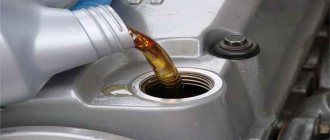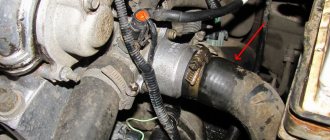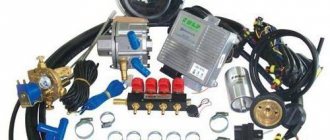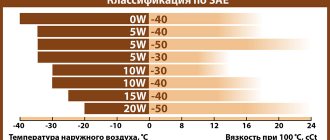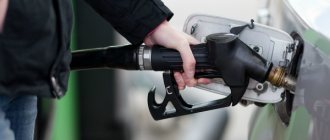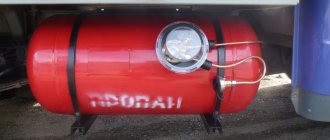Of course, on the secondary market you can find a sufficient number of gasified cars (in almost any class) imported from Europe. However, recently gasification of cars is actively gaining popularity in the Russian Federation. Gas equipment sets are installed depending on the type of vehicle and daily fuel consumption.
An extensive network of gas stations, which can be found in more detail here, makes it possible to forget about the routine of finding the nearest gas station to your home using electronic maps. The following publication will provide advice on how to refuel your car with liquefied gas yourself.
The need to use a special adapter
Of course, a gun with gas fuel can be connected to the car’s filling tank exclusively using the above-mentioned adapter. To install it, just open the gas tank flap and remove the small cap.
The gas adapter will be installed into this hole (often located to the left of the hole where ordinary gasoline is poured).
Note that the gas filling gun is somewhat structurally different from its analogue that uses gasoline fuel. The bottom line is that liquefied gas always comes under high pressure.
It is recommended to install the gun into the adapter as follows:
- install the gun into the adapter;
- press the large trigger (located along the entire handle);
- install the large trigger on the blocker;
- press the button on the column responsible for supplying gas fuel;
- keep the button pressed all the time until the required amount of gas is filled.
It should be understood that after releasing the button, the gas supply from the storage will be stopped. If you press the button again, it will not recover. Therefore, you will first have to go and pay for gas, and then continue refilling.
Basic precautions and rules
Before visiting a gas station, you should visually inspect the car so that if there is damage to the fuel system, you can detect it in time. It is strictly prohibited to refill a gas cylinder if:
- there is damage, cracks or dents on the fuel tank;
- valves are faulty, which can cause a fire;
- the clamp connected to the fuel tank is skewed;
- the cylinder inspection period has expired;
- You can smell gas, which indicates a leak.
Even seemingly insignificant damage to gas equipment can cause a fire, explosion, or failure of various vehicle components.
For your own safety and the protection of others, you cannot:
- Smoking and using various fire sources (lighters, matches, etc.).
- Refuel the vehicle with the engine running. Refueling with the engine running can lead to malfunctions in the gearbox, valves and other system elements.
- During the refueling process, switch from gasoline to gas fuel and vice versa.
- Refill the fuel tank when there are people in the car.
- Start refueling if the gun is not positioned correctly.
Replenishment of fuel at a gas station is carried out under the direction of the station operator, so it is prohibited to start without his command. If the car is equipped with a manual transmission, you need to put it on the handbrake when leaving. The automatic must be set to parking mode.
Is it profitable to switch from gasoline to natural gas motor fuel?
Car owners will be encouraged to switch their cars from gasoline to gas. The authorities are ready to almost completely cover their expenses. Energy Minister Alexander Novak proposed increasing government subsidies for converting cars to natural gas fuel to 60%. Gazprom will cover another 30% of expenses. As a result, Russians will only have to pay 10% of the total cost of the refurbishment. According to media reports, the government supported Alexander Novak’s initiative.
What are the pros and cons of this idea? And will drivers be interested in it? Chairman of the Russian Motorists Movement Viktor Pokhmelkin believes that the program looks beneficial both for car owners and for the authorities: “As far as I know, there really aren’t many such cars. Still, gasoline and diesel engines are somehow more familiar to our motorists. There were no incentives to drive on gas. If they appear now, I believe that some of the motorists will probably take advantage of these offers.
Cars run on both fuels; the difference is purely economic. It all depends on the cost of refueling and how intensively the car consumes it. It's cheaper to use gas.
In my opinion, the motives are not so much environmental as selfish economic. I think that there is a certain lobbying on the part of gas workers. Maybe what also plays a role here is that we need to, so to speak, gradually move away from gasoline engines, given the problems with oil, its depletion and prices.”
How car manufacturers prove the efficiency of gas engines
As they say, one kilometer of travel on gas will cost three times less than on gasoline, if we are talking about a car with an average fuel consumption of seven liters per 100 km. However, subsidies from the state are unlikely to be of interest to a large number of car owners, largely due to problems with infrastructure, says Alexander Kazachenko, vice-president of the Automotive Service Association: “Switching to gas cars is good and healthy - in principle, it’s saving money. But, on the other hand, our infrastructure is absolutely not ready for this. I know what problems exist when refueling cars. Imagine: a bus takes 30 minutes to refuel with methane, a car - about five to seven minutes. You can count the number of methane gas stations in Moscow on one hand; in St. Petersburg there are three or four of them, in Perm - one, in other cities, roughly speaking, one at a time. It is impossible to travel by gas from Moscow to St. Petersburg - there will be no gas stations along the way.
If there was infrastructure, I would be happy to convert my car, which consumes 25 liters of gasoline, to methane; the costs would be half as much.
Now the fifth, sixth generation of conventional propane-butane costs around 65 thousand rubles. To do this, a car service center must train its employee, which costs on average from 20 to 40 thousand rubles, and obtain the right to service gas-powered vehicles and service gas cylinder systems. On average, it will cost about 100 thousand rubles per person.”
According to RBC, in March of this year in Russia there were 484 gas stations with natural gas motor fuel. Of these, almost 70% belong to the Gazprom group.
Liliya Galyavieva
Where should you not go?
Although this procedure can be performed at almost every gas station, where there are not even special cylinder points, it is not worth buying liquefied gas there. This is quite risky because:
- After this procedure there is no check for gas leaks.
- There is no control of gas stations, which makes the use of such gas equipment unsafe.
- Due to the format of the filling column, the cylinder cannot be filled efficiently.
According to the standards, the filling volume should not be higher than 85%. This creates a “steam cap” in the cylinder, which protects against the risk of the cylinder exploding due to high temperatures. In car cylinders, compared to household ones, there is a cut-off valve that allows you to prevent gas overflow. Therefore, equipment must be checked on scales. Where is the best place to refill a gas cylinder? You can also go to car gas stations, provided they have special equipment and a license.
Gas to the engines!
The emerging international transport route “Europe - China” (MTM) will recreate the historical “Silk Road”, which connected Europe and Asia for more than one millennium.
The transcontinental highway is expected to open by 2024. In Kazakhstan and China, all sections of the MTM have already been formed; in Russia, the construction of the M11 Moscow - St. Petersburg and the Central Ring Road is being completed, and new roads are being prepared for the construction. While road workers are assessing the cost and looking for investors for the construction of new sections of the MTM, the largest energy companies in Russia, China and Kazakhstan have teamed up to, with the opening of an important trade route, begin to operate transport on it using cost-effective fuel - liquefied natural gas (methane).
In September, Gazprom, China National Petroleum Corporation (CNPC) and KazMunayGas organized the world's longest motor rally of liquefied natural gas (LNG) equipment, “Gas to Engines”. The purpose of the international motor rally is to show the scale of use of the existing and determine the locations of promising gas filling infrastructure on the transcontinental transport route Europe - China, as well as to test Russian factory equipment running on methane.
In 30 days, the rally participants covered 9,881 km across the territories of China, Kazakhstan and Russia. Gas engine technology has successfully passed the test, demonstrating high reliability, safety, environmental friendliness and efficiency.
Top gas
Top gas is a by-product of blast furnaces that is recovered at the furnace outlet.
Together with the gas, a significant amount of dust is removed from the blast furnace, the content of which when smelting using prepared ore is 30-40 g/m3, and when using dusty ores it reaches 50-100 g/m3. The use of dust-contaminated gas as fuel is unacceptable for many modern burners and units. Therefore, the gas is cleaned of dust to a residual concentration of 0.01-0.02 g/m3.
The gas is subjected to sequential coarse, semi-fine and fine purification. During rough cleaning, dust is deposited as a result of an increase in gas volume and a decrease in its speed when the gas moves from a smaller section to a larger one. This occurs in dust collectors with radial gas supply and cyclones with tangential gas supply. In these dust collectors, up to 80% of all dust is deposited and the dust content is reduced to 1-4 g/m3.
Rice. 6. Top gas burns
Rice. 7. Top gas in the structural diagram of cast iron smelting
Semi-fine gas purification is usually carried out in wet dust collectors, for example in scrubbers, in which the gas passes through wooden nozzles, and a stream of water sprayed by nozzles moves towards it. Dust is captured by water and carried away with it. The scrubbers' productivity is more than 25 thousand m3 of gas per hour with a water consumption of up to 0.0027 m3/m3 of gas. The degree of cleaning when operating furnaces at low pressure is about 0.5 g/m3, and at high pressure it reaches 0.05 g/m3.
Fine gas purification is most often carried out using the wet method in electric precipitators or disintegrators and sometimes the dry method in filters made of fabrics or synthetic materials.
Filling cars with gas
Versatility is another advantage of refueling a car with gas. When installing gas equipment, the driver still has the opportunity to refuel the car with the fuel for which its engine was originally intended. This allows the use of different fuels depending on what is available at that moment. Even for motorists who prefer to drive on gasoline or diesel, there is an opportunity to refuel with propane, the quality of which is usually better than that of conventional fuel - this is useful on a long journey when you have to visit an unfamiliar gas station.
How to fill a car with gas
An extensive network of gas stations, which can be found in more detail here, makes it possible to forget about the routine of finding the nearest gas station to your home using electronic maps. The following publication will provide advice on how to refuel your car with liquefied gas yourself.
Of course, on the secondary market you can find a sufficient number of gasified cars (in almost any class) imported from Europe. However, recently gasification of cars is actively gaining popularity in the Russian Federation. Gas equipment sets are installed depending on the type of vehicle and daily fuel consumption.
Is it possible to refuel a car with household gas and how profitable is it?
The presence of gas flowing through the meter in the house haunts a considerable number of car owners who are not satisfied with the current level of prices set for fuel.
Is it possible to refuel the car with household gas?
Principle of operation. Car owners have access to two types of gas powering their cars, which can be used in almost all types of gasoline or diesel engines, but only one. These gases are propane and methane. What should a vehicle owner know about these types of gas?
- Propane. The use of propane for refueling cars is carried out in its liquefied form, and it is in a cylinder with a low level of pressure. There are many opportunities to convert a machine to run on propane and it is not too expensive. There are a sufficient number of propane gas stations throughout the country. Sold in liters, but sometimes converted to kilograms;
- Methane. The use of methane for refueling cars is carried out using a cylinder, where it is under fairly high pressure. Purchasing gas equipment to convert a car to run on methane is much more expensive than propane equipment. There are fewer gas stations; measurements and sales are carried out in cubic meters.
It is methane under low pressure that comes out of the pipe in an ordinary apartment, contrary to popular belief that propane is used there. The fact is that there is no household equipment for liquefying propane in the form of gas, and it is not easy for a simple car owner to get it. And methane in a gaseous state is available to everyone whose home is equipped with a stove with a centralized gas supply. If methane is compressed to the required pressure, which is about 200 atmospheres, it can be pumped into car cylinders without any problems.
In addition, it is for solving such problems that there is special compressor equipment for domestic needs. These are small compressor stations that can be installed on a garage wall. Abroad they are called “gas fuelmaker”. Similar devices of greater power and size are available at gas filling stations. It works as follows. The hose is connected to the filling fitting of the cylinder, after which the station is activated. The balloon will be fully inflated throughout the night. The design of the station includes a large number of sensors to protect against excessive pressure and other unusual situations.
Negative sides. Despite the fact that the first impression of this device may be deeply positive, you should not rush to rejoice, since it also has enough disadvantages. The main ones can be identified as follows:
- The most serious obstacle to organizing the operation of such a gas station is its price. The most affordable models made in Italy today will cost the buyer at least 350 thousand rubles, those made in Thailand are about ¼ cheaper. It is better not to deal with Chinese devices, as well as with used stations. They should not be used if you are not a gas engineer and do not have sufficient knowledge to troubleshoot problems yourself;
- In order to successfully use such technology, the car owner must live in a private house, since it is not possible to implement this in an apartment. It won’t be possible to place a car in it, and putting a high-pressure hose out the window would be a crazy thing to do;
- According to Russian laws, unlike European ones, it is not possible to install gas compressor equipment near residential premises. Gas service workers will not undertake to connect, much less service, such devices. And during a periodic inspection, the owner will be fined for discovering such a device;
- Equipment for refilling cylinders with methane is not cheap and will take a long time to pay for itself.;
- Long process time.
Bottom line. Despite the fact that the use of such a station makes it possible to save money, its use is not possible everywhere, and is associated with great difficulties in operation, so it will not always be profitable.
- Camp Jeep: when the coolest off-road vehicles gather in one place
See all photo news >>
Coke gas
Coke oven gas is a flammable gas formed during the coking process of coal, that is, when it is heated without air access to 900-1100 ° C. Coke oven gas contains many valuable substances, for example, hydrogen, methane, carbon oxides, coal tar vapors, benzene, ammonia, hydrogen sulfide, etc. The vapor-gas mixture of released volatile products (up to 25% of total mass of processed coal) is subjected to cooling by water injection (from 70 to 80 °C), which ensures the separation of volatile products. In this case, most of the resins are released from the vapor phase; further cooling of the vapor-gas mixture is carried out in shell-and-tube refrigerators (up to 25-35 °C).
The condensates are combined and the tar water (ammonia water) and coal tar are separated by settling. Next, the raw coke oven gas is successively purified from ammonia and hydrogen sulfide, washed with absorption oil (to capture raw benzene and phenol), and sulfuric acid (to capture pyridine bases). Purified coke oven gas (14-15% of the total mass of processed coal) is used as fuel for heating coke oven batteries and for other purposes.
Rice. 4. Separation of coke oven gas into components
At the very beginning of the use of coal coking technology, the resulting by-product - coke oven gas - was used for lighting, cooking and heating. The development of gas production paralleled the Industrial Revolution and urbanization, and the production of by-products, coal tar and ammonia, were important raw materials for chemical dyes and the chemical industry. All types of artificial dyes were made from coke oven gas and tar.
Rice. 5. Use of coke oven gas (Avdeevsky Coke and Chemical Plant)
Currently, coke oven gas is used as fuel in metallurgical plants, in public utilities and as a chemical raw material. It is also used as fuel in industrial furnaces, gas engines, and as a raw material in the chemical industry. From coke oven gas is isolated
hydrogen necessary for the synthesis of ammonia by fractionated condensation at low temperatures. The resulting ethylene fraction serves as a raw material for various syntheses.
The admixture of hydrogen sulfide in coke oven gas is undesirable both in cases where the gas is used as fuel and when it is a chemical raw material. Therefore, coke oven gas is purified from hydrogen sulfide. Various methods are used to purify gases.
Dry cleaning methods include the method of gas purification using swamp ore. This method can remove hydrogen sulfide almost completely, up to a hydrogen sulfide content of 0.02 g/m3. Therefore, in cases where thorough purification of gas is necessary, for example when using it in everyday life, they first resort to wet and then dry cleaning.
The vacuum-soda method for purifying coke oven gas from hydrogen sulfide is as follows. The gas is supplied to the scrubber, which is irrigated with a 4-5% soda solution at 30 °C. Hydrogen sulfide, and with it carbon dioxide and hydrocyanic acid, present in the gas in small quantities (0.5-1.2 g/m3), are absorbed, forming salts.
